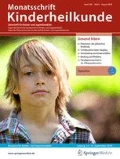Zusammenfassung
Fragestellung: Ist die Bestimmung der kreatininbezogenen Ausscheidung von Deoxypyridinolin (DPD/Cr) und Pyridinolin (PYD/Cr) bei Kindern mit Störungen des Kalziumphosphatstoffwechsels sinnvoll?
Patienten/Methoden: DPD/Cr und PYD/Cr wurden mittels 2er kompetitiver Enzymimmunoassays im Morgenurin bei 102 gesunden Kindern und 50 Patienten mit Knochenstoffwechselerkrankungen (Vitamin-D-Mangel-Rachitis; Phosphatdiabetes; Pseudohypoparathyreoidismus) zusammen mit der kreatininbezogenen Hydroxyprolinausscheidung untersucht.
Ergebnisse: Bei Gesunden korrelierten PYD/Cr und DPD/Cr (r=0,59; p≤0,001), PYD/Cr und kretatininbezogene Hydroxyprolinausscheidung (r=0,72; p≤0,001) sowie DPD/Cr und kreatininbezogene Hydroxyprolinausscheidung (r=0,42; p≤0,001). PYD/Cr und DPD/Cr waren altersabhängig mit hohen Werten bei Säuglingen und Kleinkindern, die bis zur Pubertät abfielen. Bei allen 3 Krankheitsbildern waren PYD/Cr und DPD/Cr mit der kreatininbezogenen Hydroxyprolinausscheidung korreliert (Vitamin-D-Mangel-Rachtitis: r=0,54, p≤0,05 bzw. r=0,72 p≤0,01; Phosphatdiabetes: r=0,36, p≤0.05 bzw. r=0,60, p≤0,001; Pseudohypoparathyreoidismus: r=0,67, p≤0,01 bzw. r=0,84, p≤0,001). Bei einigen Patienten mit Vitamin-D-Mangel-Rachitis, Phosphatdiabetes und Pseudohypoparathyreoidismus konnten z.T. erheblich erhöhte Werte für PYD/Cr (Vitamin-D-Mangel-Rachitis: n=6, Phosphatdiabetes: n=14, Pseudohypoparathyreoidismus: n=4), DPD/Cr (Vitamin-D-Mangel-Rachitis: n=7, Phosphatdiabetes: n=14, Pseudohypoparathyreoidismus: n=4) und die kreatininbezogene Hydroxyprolinausscheidung (Vitamin-D-Mangel-Rachitis: n=8, Phosphatdiabetes: n=17, Pseudohypoparathyreoidismus: n=5) gefunden werden.
Schlußfolgerung: Bei Kindern kann der Knochenumsatz durch die Bestimmung von PYD/Cr, DPD/Cr und der kreatininbezogenen Hydroxyprolinausscheidung bestimmt werden. Die alleinige Messung von DPD/Cr ist jedoch sehr viel einfacher, spezifischer und sensitiver als die Bestimmung der kreatininbezogenen Hydroxyprolinausscheidung und könnte in Zukunft ein wertvolles diagnostisches Werkzeug für Kinder mit Kalziumphosphatstoffwechselstörungen werden.
Summary
Background: Pyridinoline (PYD) und deoxypyridinoline (DPD) urine levels are known to reflect bone turnover in adults. However few data exist for PYD und DPD excretion in children.
Patients and methods: We determined the PYD- and DPD-creatinine ratio (PYD/Cr, DPD/Cr) in 102 healthy children and 50 children with bone related diseases (vitamin D-deficiency rickets; X-linked hypophosphataemic rickets; pseudohypoparathyroidism). PYD/Cr and DPD/Cr were determined in the fasting morning urine using two competitive enzymimmunoassays together with the hydroxyproline/creatinine ratio.
Results: In healthy children significant correlations were found for: PYD/Cr and DPD/Cr (r=0.59; p≤0.001), PYD/Cr and hydroxyproline/creatinine ratio (r=0.72; p≤0.001) and DPD/Cr and hydroxyproline/creatinine ratio (r=0.42; p≤0.001). All values were age dependent with high levels in infancy and early childhood declining towards puberty. In the patients PYD/Cr and DPD/Cr correlated significantly with the hydroxyproline/creatinine ratio (vitamin D-deficiency rickets: r=0.54, p≤0.05 and r=0.72, p≤0.01; X-linked hypophosphataemic rickets: r=0.36, p≤0.05 and r=0.60, p≤0.001; pseudohypoparathyroidism: r=0.67, p≤0.01 and r=0.84, p≤0.001 respectively). In some patients with vitamin D-deficiency rickets, X-linked hypophosphataemic rickets and pseudohypoparathyroidism marked elevations were found for PYD/Cr (vitamin D-deficiency rickets: n=6, X-linked hypophosphataemic rickets: n=14, pseudohypoparathyroidism: n=4), DPD/Cr (vitamin D-deficiency rickets: n=7, X-linked hypophosphataemic rickets: n=14, pseudohypoparathyroidism: n=4) and hydroxyproline/creatinine ratio (vitamin D-deficiency rickets: n=8, X-linked hypophosphataemic rickets: n=17, pseudohypoparathyroidism: n=5).
Conclusion: Our data show, that bone turnover can be assessed by PYD/Cr, DPD/Cr or hydroxyproline/creatinine ratio determination. However, the measurement of DPD/Cr alone may be sufficient, faster and easier to perform than hydroxyproline/creatinine ratio determination and could prove a valuable diagnostic tool for assessing bone turnover in children.
Author information
Authors and Affiliations
Rights and permissions
About this article
Cite this article
Agbenu, J., Kruse, K. Ausscheidung von Kollagen-Crosslinks im Morgenurin Ein diagnostischer Index für den Knochenumsatz. Monatsschr Kinderheilkd 145, 822–828 (1997). https://doi.org/10.1007/s001120050184
Issue Date:
DOI: https://doi.org/10.1007/s001120050184

